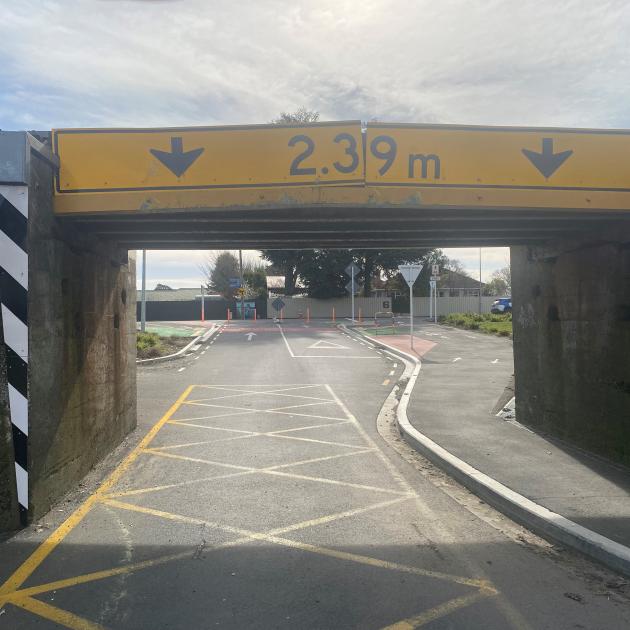Top Stories
Tinwald Viaduct Closed Again After Vehicle Collision Sparks Debate

A vehicle collision has led to the closure of the Tinwald viaduct in Ashburton, New Zealand, once again raising questions about the future of the bridge. The overpass, which has been dubbed the most frequently struck bridge in the country, is now closed to traffic as repairs are initiated following an incident involving an excavator being towed on a trailer on July 29, 2023. This closure has prompted discussions about whether the bridge should be permanently shut to prevent future collisions.
The Tinwald viaduct spans a short road that runs beneath the main south railway line, with a maximum clearance height of just 2.39 meters. According to KiwiRail, the viaduct has experienced an average of 13 documented strikes per year over the last two years. Residents have voiced concerns that the actual number of incidents may be higher, with local resident Kevin Donaldson stating that the bridge is hit or nearly struck at least once a week.
KiwiRail’s chief infrastructure officer, Siva Sivapakkiam, confirmed that the closure is a precautionary measure to prevent further damage and ensure safety for both rail and road users. Damage to the overhead impact beam and other structural elements has necessitated the repairs. “This leaves the bridge vulnerable to future undocumented strikes, which could pose a threat to the safety of rail and nearby road users,” Sivapakkiam explained.
Currently, KiwiRail is assessing the damage and working with design engineers to determine the best course of action for repair and replacement of the impact beams. Initial estimates suggest the repairs could take between six to eight months, depending on the extent of the damage.
Community Reactions and Concerns
The prospect of a permanent closure has sparked mixed reactions within the local community. Adam Kibblewhite, a resident of Tinwald, expressed his concerns through an open letter to the Ashburton District Council and KiwiRail. He highlighted growing anxiety among residents that the temporary closure could become permanent. Despite some support for closure, Kibblewhite noted that many community members prefer to find solutions to reduce the frequency of strikes rather than shutting down the viaduct entirely.
While Kibblewhite acknowledges the challenges posed by over-height vehicles, he believes that implementing preventative measures, such as a gantry to restrict vehicle height on the western side of the viaduct, would be more effective. He criticized the proposed timeframe for replacing the damaged beam, arguing that the bridge’s structural integrity remains intact, as it continues to be used by trains.
Discussions about the viaduct’s future have also included the possibility of restricting traffic flow. Previous proposals aimed to limit vehicle movements to left turns only onto the state highway to improve safety. However, following community consultations, the New Zealand Transport Agency (NZTA) decided to retain full access, focusing instead on monitoring vehicle safety at intersections.
Future Considerations and Solutions
As the situation unfolds, the Ashburton District Council has indicated its intention to reopen the viaduct once repairs are completed. Neil McCann, the council’s infrastructure and open spaces manager, confirmed that discussions about making the road one way have not advanced. The temporary closure was discussed at the council’s activity briefing on July 30, where roading manager Mark Chamberlain stated that the primary concern was to prevent the bridge from being struck again.
Chamberlain pointed out that while signage and monitoring have been improved, the only way to prevent collisions might be to prohibit vehicles from using the bridge altogether. “You can put all the signage you like; someone will still hit it at some stage,” he remarked.
Local officials are weighing the costs and practicality of additional preventive measures. Chamberlain noted that while it could be cheaper for KiwiRail to invest in preventative devices, the decision ultimately rests with the council.
Previous investigations have looked into the feasibility of installing gantries over the approach roads, but concerns about structural integrity and costs have complicated these plans. The estimated cost for such a structure was around $20,000 per gantry, but this figure was based on initial concepts rather than finalized designs.
As the community navigates this challenging situation, residents continue to advocate for solutions that prioritize safety while maintaining access to the vital route that the Tinwald viaduct provides. The ongoing discussions reflect the delicate balance between infrastructure needs and community safety, as Ashburton seeks a resolution to this persistent issue.
-

 Sports1 month ago
Sports1 month agoNetball New Zealand Stands Down Dame Noeline Taurua for Series
-

 Entertainment1 month ago
Entertainment1 month agoTributes Pour In for Lachlan Rofe, Reality Star, Dead at 47
-

 Entertainment1 week ago
Entertainment1 week agoNew ‘Maverick’ Chaser Joins Beat the Chasers Season Finale
-

 Sports1 month ago
Sports1 month agoSilver Ferns Legend Laura Langman Criticizes Team’s Attitude
-

 Entertainment2 months ago
Entertainment2 months agoKhloe Kardashian Embraces Innovative Stem Cell Therapy in Mexico
-

 Sports2 months ago
Sports2 months agoGaël Monfils Set to Defend ASB Classic Title in January 2026
-

 World3 months ago
World3 months agoPolice Arrest Multiple Individuals During Funeral for Zain Taikato-Fox
-

 Politics2 weeks ago
Politics2 weeks agoNetball NZ Calls for Respect Amid Dame Taurua’s Standoff
-

 Entertainment3 weeks ago
Entertainment3 weeks agoTyson Fury’s Daughter Venezuela Gets Engaged at Birthday Bash
-

 Sports3 weeks ago
Sports3 weeks agoHeather McMahan Steps Down as Ryder Cup Host After Controversy
-

 Entertainment3 weeks ago
Entertainment3 weeks agoTyson Fury’s Daughter Venezuela Gets Engaged at Birthday Bash
-

 World3 weeks ago
World3 weeks agoNew Zealand Firefighters Plan Strike on October 17 Over Pay Disputes



















